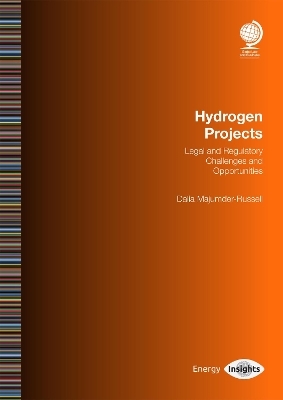
Hydrogen Projects
Globe Law and Business Ltd (Verlag)
978-1-78742-442-5 (ISBN)
Hydrogen, the most abundant element in the universe is often cited as the key to unlock the decarbonisation of sectors such as transport, heating and industrial processes, while also transforming the role that renewable energy plays in the electricity mix. Together with carbon capture and storage technology or coupled with renewable generation, this energy vector is a likely key pillar in the ongoing energy transition. This Special Report considers the key legal and regulatory challenges and opportunities in developing, financing and operating hydrogen projects, including:
Key technologies, methods and hydrogen's role in the net zero agenda;
Key stakeholders and their roles;
Key policies and legal frameworks; and
Revenue streams, commercial models and issues for financiers.
The Special Report will also consider how hydrogen can be used in industrial processes, transport and the heating sectors. Written for a legal and non-legal audience, this report will appeal to those looking for a deeper understanding of the opportunities in the hydrogen sector and ways in which some of these may be realised.
1. Introduction
1.1 What do we mean when we talk about hydrogen?
1.2 How does it answer the decarbonisation question?
1.3 Why hydrogen/what’s the size of the opportunity? Where can it be used most effectively?
1.4 How does it help achieve net-zero? Timeline
2. Who are the stakeholders and their roles
2.1 Government/regulators
2.2 System and network operators
2.3 Operators (of various parts of the chain including electrolysers)
2.4 Consumers
2.5 Financiers/insurers
3. Production of hydrogen
3.1 Different types of hydrogen (green, blue, grey)
3.1.1 Focus on green hydrogen + electrolysis
3.1.2 Blue hydrogen with carbon capture (eg, Cadent work)
3.2 What are the differences, how are the different types of hydrogen made?
3.3 Regulation of hydrogen production
3.4 Issues and opportunities
3.4.1 Carbon price
3.4.2 Cost competitiveness
4. Transportation and storage of hydrogen
4.1 Gas/pipeline regulations (transmission and distribution level)
4.1.1 Health and safety issues
4.1.2 Industry codes (UNC, GSMR)
4.1.3 Property issues
4.2 Issues in retrofitting existing stock/consenting to build new pipelines
4.3 Construction/Operation/Decommissioning of pipelines
4.4 Revenue considerations (offtake, price controls, subsidies)
4.5 Issues and opportunities
5. Using hydrogen for industrial processes
5.1 Context and use of hydrogen in industry
5.2 Role of blue hydrogen/CCUS policy dependencies
5.3 Regulations
5.3.1 Health and safety issues
5.3.2 Consenting issues
5.3.3 Property issues
5.4 Construction/Operation/Decommissioning of plant
5.4.1 Risk allocation
5.4.2 Polluter pays principle (especially on CCS)
5.5 Revenue considerations (offtake/cost competitiveness, subsidies)
6. Using hydrogen for heating/cooling
6.1 How and where does this work
6.2 Legal issues
6.2.1 Regulatory framework for heating
6.2.2 Health and safety issues
6.2.3 Consenting issues
6.2.4 Property issues
6.3 Revenue considerations (offtake, price controls, subsidies) – same as pipelines
6.3.1 Interactions with other renewable heat programmes (heat pumps, RHI)
6.4 Consumer experience and equipment suitability
6.5 Issues and opportunities
7. Using hydrogen for transport
7.1 Use in:
7.1.1 Road transport (HGVs and fleets) – alongside EVs
(a) including hydrogen transportation by compressed gas cylinders, HFCs
7.1.2 Rail transport
7.1.3 Marine transport (ferries and freight shipping)
7.2 Legal issues
7.2.1 Regulatory framework for transport
7.2.2 Health and safety issues
7.2.3 Consenting issues – especially retrofitting existing infrastructure
7.3 Revenue considerations
7.3.1 Interactions with other renewable fuel programmes (RTFO)
7.4 Consumer experience and concerns
7.5 Issues and opportunities
8. Using hydrogen for energy system management
8.1 How and where would this work
8.2 Stakeholders
8.2.1 System/network operator
8.2.2 Building operator
8.2.3 Consumers
8.3 Revenue sources
8.3.1 Ancillary services
8.3.2 New services eg, V2G
8.4 Consumer experience (hydrogen as part of energy as a service)
8.5 Issues and opportunities
9. Issues in M&A and financing of hydrogen projects
9.1 Overview
9.1.1 Key structures
9.1.2 Key financing terms
9.1.3 Key requirements for investment
9.2 Issues and opportunities
9.2.1 For investors
9.2.2 For financiers (including measuring ESG impacts)
10. Conclusion
10.1 Developing the hydrogen economy – what’s the outlook like to 2050?
10.2 What else is needed for net zero and how can hydrogen play a significant role?
10.3 Who will win the hydrogen race and why?
11. Case studies
11.1 Portugal policy development and green hydrogen
11.2 Germany – Alstom trains
11.3 Singapore
11.4 Australia – coordinated policy approach
11.5 Mining – Mongolia
11.6 ITM Power partnership with Orsted
11.7 Wrightbus – hydrogen buses (across UK cities)
11.8 EU green deal policy
11.9 Danish freeports initiative
| Erscheinungsdatum | 28.07.2021 |
|---|---|
| Verlagsort | London |
| Sprache | englisch |
| Maße | 210 x 297 mm |
| Themenwelt | Recht / Steuern ► EU / Internationales Recht |
| Recht / Steuern ► Öffentliches Recht ► Umweltrecht | |
| ISBN-10 | 1-78742-442-1 / 1787424421 |
| ISBN-13 | 978-1-78742-442-5 / 9781787424425 |
| Zustand | Neuware |
| Haben Sie eine Frage zum Produkt? |
aus dem Bereich


